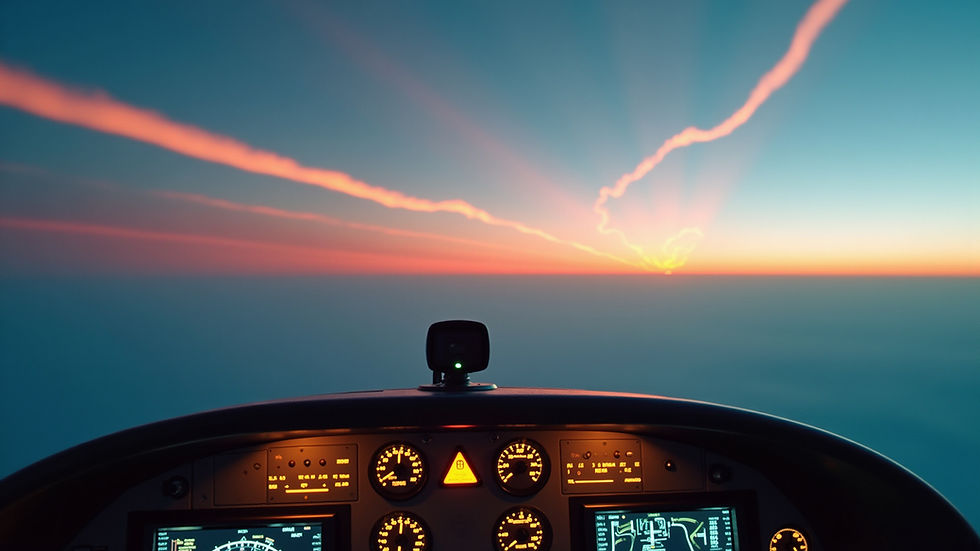Blog 1: So You Want to Fly? Here's How to Start
- Aalisha Sugur

- Jan 4
- 3 min read

“Every time I step into the cockpit, I feel more alive and more focused than anywhere else.”— Aalisha, Student Pilot, Princeton Flying School
Introduction: Your Aviation Journey Begins Here
There’s a moment when you first sit in the pilot’s seat, your hand on the throttle, headset humming, and the runway stretching ahead — and you realize, this isn’t just a dream. This is real. This is where your flying story begins.
Whether you're in high school like me, exploring aviation through drones, or simply someone who’s always looked up at the sky with curiosity — this guide will help you take that first serious step toward becoming a pilot.
Step 1: Understand Why You Want to Fly
Ask yourself what drives your passion for aviation. Are you looking to fly as a hobby, travel on your own schedule, pursue a career in the airlines, or join the military? Or maybe you’re a drone pilot (like I was) who wants to make the jump to crewed aircraft. Your “why” will influence your training path, budget, and how far you want to go.
Common Motivations:
Recreational flying (PPL only)
Commercial pilot career (CPL + Instrument + Multi-engine)
Drone to aircraft transition (Part 107 to PPL)
STEM education, aerospace exploration, or future engineering paths
Step 2: Learn the FAA Certification Pathways
The Federal Aviation Administration (FAA) is the governing body for all aviation licensing in the U.S. Here are the most common pathways:
Student Pilot Certificate – Required before solo flights. Apply via IACRA.
Private Pilot License (PPL) – First full license. Lets you fly single-engine aircraft recreationally.
Part 107 Remote Pilot Certificate – For commercial drone operations (I earned this before flight school).
Instrument Rating – For flying in clouds or low visibility.
Commercial/ATP License – For career airline or cargo pilots.
🛠️ Resources: FAA Airman Certification Standards, AOPA’s “How to Become a Pilot” Guide, FAA Handbooks
Step 3: Choose a Flight School That Fits You
You’ll hear about Part 61 and Part 141 flight schools. Both are FAA-approved but offer different structures:
Part 61: Flexible scheduling. Ideal for high school or college students like me.
Part 141: More structured and faster-paced. Often part of college programs.
Make sure your school has certified flight instructors (CFIs), well-maintained aircraft (usually Cessna 172 or Piper models), and offers ground school support. I’m training at Princeton Flying School in New Jersey — a great school with hands-on instructors and access to a control towered airport.
Step 4: Pass Your FAA Medical Exam
You’ll need a Third-Class Medical Certificate to fly solo or earn a PPL. Schedule with an Aviation Medical Examiner (AME) near you. It includes vision, hearing, heart, and general health checks.
💡 Tip: Search AMEs at faa.gov/pilots/amelocator
Step 5: Begin Ground School (Even Before Your First Flight)
Ground school covers theory — how airplanes fly, how to read weather reports, interpret sectional charts, and communicate with ATC. It’s intense, but rewarding.
Ground School Options:
Sporty’s Learn to Fly Course – Highly rated online course
King Schools – Engaging videos, FAA-style test prep
ASA/Jeppesen Textbooks – Classic print + online formats
📘 FAA Study Guide: Pilot’s Handbook of Aeronautical Knowledge
Step 6: Book Your Discovery Flight
Almost every school offers a low-cost, no-pressure intro flight (called a discovery flight). You’ll sit in the pilot’s seat, follow along with the instructor, and maybe even take the controls.
What to Expect:
Preflight inspection and safety briefing
Hands-on time with the yoke or stick
Views that will stay with you forever
My discovery flight changed everything. It transformed aviation from a textbook concept into a living experience. That’s when I knew — this wasn’t just a goal, it was a mission.
Step 7: Start Logging Flight Hours
To earn a PPL under Part 61, you need at least:
40 total hours of flight time
20 hours with an instructor (dual)
10 hours of solo flight
Cross-country and night flight requirements
Your instructor will help you track everything in your logbook — either on paper or digitally (apps like ForeFlight or MyFlightBook).
Estimated Costs
Flight training isn't cheap, but it’s worth it. Typical costs for a PPL range from $10,000–$15,000 depending on school, location, and flight frequency. Scholarships from organizations like Women in Aviation, EAA, AOPA Foundation, and local flight clubs can offset costs.
Closing Thoughts: Just Take Off
You don’t need to be a genius, a math wizard, or a future astronaut to learn to fly. You just need passion, discipline, and a willingness to show up and learn — even on hard days.
As a student pilot and drone operator, I’ve seen aviation from both sides — and I’m still in awe every time I rotate off the runway.
🛩️ Until next time,
Aalisha
Student Pilot | FAA Part 107 Drone Certified
Future PPL | Aviation Blogger



Comments